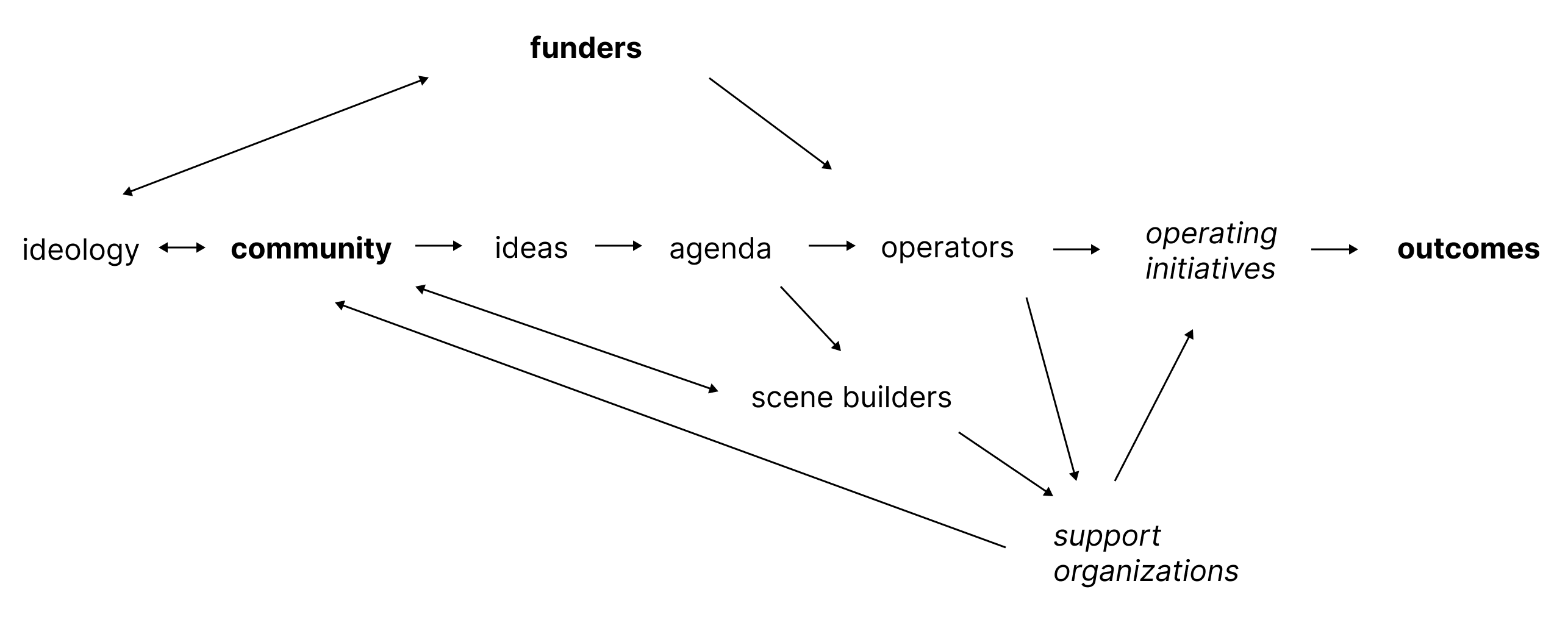(2022-05-22) Eghbal Idea Machines
Nadia Eghbal on Idea machines. Tech as a system of values, and not just an industry, is heavily driven by its subcultures and their ideologies. Where do these ideologies come from, and how do they influence what’s accomplished? cf Scenes, Collaborations, Inventions, And Progress, Theory of Change
One of the most visible ideologies in tech is effective altruism (or EA)
Although I’m not an EA, I think effective altruism is a useful blueprint for understanding a growing number of influential subcultures in tech right now, from progress studies to It’s Time to Build to crypto public goods funding.
EA is the strongest example of what I think of as an Idea Machine: a network of operators, thinkers, and funders, centered around an ideology, that’s designed to turn ideas into outcomes.

Effective altruism’s strength lies in its infrastructure, which we can use to better understand how other idea machines work, what their impact will be, and what’s needed to make them more effective.
If we were to take EA literally, however, we’d be saying that there is an objectively best way to accomplish these outcomes, and that that way is discoverable: that complex social problems are a finite, solvable game.
If philanthropy is pluralistic – and, like any idea marketplace, that is one of its virtues – then there is no single school of thought that can “solve” complex social questions
why aren’t there more effective altruisms? It’d be like if there were just one startup
Although I don’t personally identify with the ethos of effective altruism, I also think they’ve done a lot of things well. EA has a remarkably good infrastructure for attracting and retaining members, identifying cause areas, and directing time and dollars towards those efforts.
it’s still the best example of what I’ve been calling an “Idea Machine” in my head
An Idea Machine is a self-sustaining organism that contains all the parts needed to turn ideas into outcomes.
ideology
generating ideas
Eventually, they form an agenda, (theory of change, Plausible Promise)
Communities need agendas to become idea machines
The agenda is capitalized by one or several major funders
As community members move from ideas to action, they might become scene builders
or operators, who drive the operating initiatives that lead to outcomes
Both types might also lend a hand to create support organizations
An Idea Machine is adept at attracting newcomers and pushing them towards outcomes. If someone says “I’m interested in effective altruism, where do I start?”, there are many clear entry points with concrete ways to think about one’s career, how to spend one’s income, and how to get involved
While there’s some evidence to suggest that EA began to mature and stagnate in the late 2010s, the appearance of another new major funder, Sam Bankman-Fried, has breathed new life into the machine – although I’d argue that SBF’s involvement could branch into a new machine in itself (see next section).
In recent years, it seems like we are starting to see more effective altruisms being built. Here are a few emerging examples I’ve noticed
We can use our previous framework to better understand which stages of development these machines are in, and how they could become more effective
Idea machines are different from movements, which are focused on achieving a specific outcome and are therefore self-limiting (if they succeed, the movement winds down). (e.g. climate change)
Movements can be fed into an idea machine, however, to accelerate their impact.
On the other end of specificity, idea machines are less broad than paradigm shifts, which are widespread, headless, decentralized shifts in cultural norms and attitudes due to changes in systemic conditions. For example, web3 is a paradigm shift, but it’s too big and distributed to be an idea machine.
For most of the 20th century, the home for idea machines was foundations, first popularized by John D. Rockefeller in the 1910s.
By the mid-20th century, foundations had reached the height of their power and influence, triggering a congressional investigation into whether foundations were manipulating public opinion and thought
It took another nearly two decades for the United States government to successfully hamstring foundations, but they finally did, with the 1969 Tax Reform Act that introduced all the paperwork we associate with foundations today: public reporting requirements
The federal regulation of foundations didn’t mean the death of idea machines, however. It just meant that that foundations were no longer the best place to house them.
The modern Idea Machine better reflects how people self-organize today. They are decentralized, more closely intertwined with public dialogue, and work symbiotically with a community that anyone can join: many individual nodes operating in a loosely-organized network, instead of a monolithic organization.
With a more decentralized structure, modern idea machines can “arm the rebels” right where they are, instead of hiring them into a foundation
DAOs are an example of idea machines that can be initialized by a community.
It’s hard to know whether the current, loosely-organized form of idea machines is its terminal state, or an inchoate form of something else
A flurry of liquidity in the last five years, as well as a strong bull market, meant that idea capital became cheaper and more plentiful, even with the current downturn. What’s more, that wealth has also become much more widely distributed
In a world where there are many wealthy people, then, and many more types of wealthy people, there are also more idea machines, and a more liquid idea marketplace.
Tools for thought still suffers from insufficient funding (perhaps best encapsulated by Dynamicland’s history). It has a community, talent, and philosophy attached to it, but until it finds an idea machine, it will be unable to realize its full potential.
Despite the recent growth, there are still not nearly as many idea machines as there should be.
Edited: | Tweet this! | Search Twitter for discussion

 Made with flux.garden
Made with flux.garden